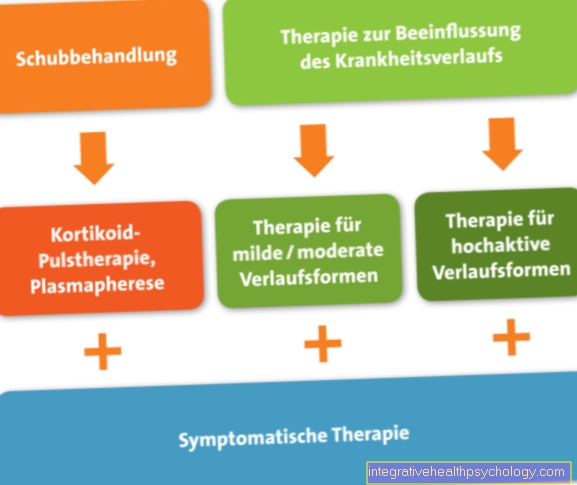RSI syndrome
introduction
The RSI syndrome (Repetitive Strain Injury) is a kind of collective term for a multitude of complaints and pains based on nerves, vessels, muscles, tendons and trigger points.
ly complaints from repetitive and stereotypical (constantly repetitive) movements and work in the forearm and hand are meant. Often there are several causes of the RSI syndrome among those affected. In German usage, this syndrome is also often known as the mouse arm. Tendovaginitis used to be mentioned. Today we know that it is more of a chronic defect in the tendons - a so-called tendinosis.

causes
One of the main causes for the development of RSI syndrome is repetitive work at the desk. Nowadays a lot of people work at the computer for almost the entire working day.
The equipment of the workplace and the sitting posture of those affected are usually not ideal and lead to long-term complaints in the back, neck and arms. When working on the computer, thousands of tiny movements and clicks occur over the course of the day. All in all, this puts a lot of strain on the forearm and finger muscles as well as tendons. There is also a lack of compensatory movements and regular breaks.
In combination with an incorrect sitting posture, the forearms may also be insufficiently supplied with oxygen. In addition, the keyboard and mouse are not ergonomically designed for most of those affected. With the typical mouse and keyboard, the hand is permanently kinked and does not rest on a pad. This represents a permanent irritation over the working day. Another factor that should not be underestimated is stress. Those affected may not even notice it and thus have a permanent unconscious state of tension. This also affects the tone of the muscles.
You might also be interested in this topic: Tendinitis
Symptoms
Patients suffering from RSI syndrome often report pain in their hands, forearms, neck or back. These are described as piercing and pulling. This pain can be acute and very severe and lead to an inability to work.
Often these pains have grown stronger over months and years or were perceived more consciously. Furthermore, there may be a deterioration over the working day. This means that the longer you work at your desk or computer, the more problems and complaints become. In addition to the pain, tingling, sensory disturbances, numbness or stiffness of the fingers and their joints can also occur. There is also the possibility of tension and pain in the neck, shoulder and head area.
In addition to the purely physical symptoms, many patients notice high stress and stress at work. The occurrence of mental health problems can be both a symptom and a part of the cause of the occurrence of RSI syndrome.
You might also be interested in this article: Pain in the index finger
Appointment with ?

I would be happy to advise you!
Who am I?
My name is I am a specialist in orthopedics and the founder of .
Various television programs and print media report regularly about my work. On HR television you can see me every 6 weeks live on "Hallo Hessen".
But now enough is indicated ;-)
In order to be able to treat successfully in orthopedics, a thorough examination, diagnosis and a medical history are required.
In our very economic world in particular, there is too little time to thoroughly grasp the complex diseases of orthopedics and thus initiate targeted treatment.
I don't want to join the ranks of "quick knife pullers".
The aim of any treatment is treatment without surgery.
Which therapy achieves the best results in the long term can only be determined after looking at all of the information (Examination, X-ray, ultrasound, MRI, etc.) be assessed.
You will find me:
- - orthopedic surgeons
14
You can make an appointment here.
Unfortunately, it is currently only possible to make an appointment with private health insurers. I hope for your understanding!
For more information about myself, see - Orthopedists.
therapy
The therapy or treatment of the RSI syndrome is largely based on the patient's own work. Doctors, therapists or other affected persons can learn a variety of everyday and work-related exercises for stretching, strengthening and mobilization that prevent the disease from progressing.
It is also part of the therapy concept that working hours at the computer and desk must be reduced or distributed differently throughout the day. The desk needs to be adapted to a more ergonomic posture of the head, upper body and arms. In addition, occupational and physiotherapy can help with other tricks for relaxation and stretching. With physiotherapy, massages, mobilization and heat or cold treatments are included in the therapy concept.
In addition to the design of the workplace, changing the lifestyle in leisure time is also part of it. Instead of sitting and lying down, it requires more movement through e.g. Jogging, cycling, swimming or other sports that force holistic movement and strengthening of the body.
To treat the pain, pain medication (e.g. ibuprofen, diclofenac) can be used for short periods. However, this should not be over longer phases, as there is no change in behavior, but rather a fixation on the pain and its treatment with the appropriate medication.
Another focus must be on reducing stress and strain. Learning about relaxation exercises for the head and body can be particularly helpful in difficult and stressful situations at work. Furthermore, the therapies of the RSI syndrome include that regular breaks, the corresponding activity, are requested and adhered to.
Read more about this: Ergonomic office chair
Exercises
There are a large number of exercises and techniques for treating and preventing this yourself.
It is essential that you exercise regularly and in a variety of ways. A central part of the exercises are the stretching exercises for the hands and forearms. Once the hand can be practiced by stretching into flexion or covering. The other hand pulls into the desired stretch. However, it should not be worked with too much force and violence.
It has a similar effect when both hands are placed against a wall with the palms of the hands. The hands are rotated slowly. Or you take your arms behind your back and grab the fingers of the other with one hand and slowly pull them upwards. All three exercises stretch the forearm muscles very well. In addition to the focus on the forearms, the entire upper body should be stretched and trained, especially after long periods of sitting. The neck, shoulder, upper arms, upper and lower back should be practiced.
More exercises can be found here:
- Exercises at the PC workplace
- Exercises for loosening up and relaxation
Duration
Many patients develop RSI over many years.
The pain and symptoms develop slowly and there are phases in which the symptoms are better and worse. When diagnosing RSI syndrome and starting treatment, no fixed period can be given until the symptoms have disappeared. Often the problems can be got under control through permanent and regular self-therapy. In addition, a long-term adjustment of sitting and working habits is an important prognostic factor.
But even then there can be cases in which the RSI syndrome does not experience any relevant improvement in the long term.
Occupational disease
The RSI syndrome has not yet been recognized as an occupational disease. The basis for recognition of an occupational disease is that a direct connection between the activity, i.e. the occupation, and the existing consequences or diseases can be established.
One can do this, for example, with a miner who may later in life suffer from dust lung or asbestosis. Here, by measuring the concentration of asbestos or other dust particles at the workplace, a comparison can be made with a scientifically developed maximum value and, based on this, the recognition of an occupational disease can be granted. This is not easily possible with an RSI syndrome.
The requirement that the RSI syndrome be recognized as an occupational disease exists and is expressed regularly. It is possible to classify these in list 2101 of occupational diseases; "Diseases of the tendon sheaths or the gliding tissue as well as the tendons or muscle attachments". Even above that, there is only a low recognition rate.
In other countries, e.g. Australia and the USA, RSI syndrome can be recognized as an occupational disease. It must be shown here how the situation in Germany will change over the next few years. Based on this, it is all the more important that employees are given appropriate opportunities for preventive (preventive) and therapeutic exercises.
You might also be interested in this topic: Desk with adjustable height
computer mouse
Working with a mouse on the computer is a causal problem for the development of RSI syndrome. Many affected people work on the mouse for several hours with poor hand position.
A good approach can be to use a specially shaped mouse that supports a more physiological hand position. There are also mouse pads with palm rests. As a result, the hand is less bent and there is less stress on the fingers and forearm. In addition to these methods, the operating system and software can be adapted for easier and more efficient use of the mouse. E.g. the double-click time can be reduced or voice control can be set up.
As further measures, regular breaks from working on the mouse should be taken and exercises and compensatory movements should be carried out.
You might also be interested in this topic: mouse arm
Sick leave with RSI syndrome
In the case of acute complaints and episodes of pain, sick leave can be given. Repeated and longer sick leave is also within the scope of the legally permitted options.
If the complaints do not improve despite changing the equipment and sitting posture at the workplace and there are repeated phases of incapacity for work, then, together with the treating doctor and the employer, possibilities for other deployment and retraining options should be sought in order to avoid occupational disability.
diagnosis
For many of those affected, a diagnosis is only made after visiting many doctors from different specialties.
In addition to tendinitis, blockages and pinched nerves in the neck area are often identified as the cause of the complaints. The fundamental problem with RSI syndrome is that the commonly used diagnostic tools, such as X-rays, CT and MRI, cannot represent an organic cause.
Usually the diagnosis of RSI syndrome is made by a doctor with background knowledge based on the collection of symptoms and the anamnesis.
Which Doctor Treats RSI Syndrome?
In principle, the diagnosis of RSI syndrome can be made by the family doctor or a general practitioner. Often, however, the classification of the complaints is difficult and the referral to an orthopedic surgeon or surgeon takes place. Unfortunately, the targeted diagnosis does not always take place here either. It can therefore be helpful to find other sufferers or to research an expert for the RSI syndrome yourself. In addition, visiting a physiotherapist or other therapist in the field of the musculoskeletal system can help.
Chances of recovery
A cure of the RSI syndrome is possible. This requires a conscious and regular therapy, which requires a lot of personal responsibility from the patient. Even after many years, stretching and strength exercises must be carried out at the desk after long periods of work. Even after a long time without pain, many patients repeatedly notice abnormalities in their forearms and hands that remind them of RSI syndrome. Should one fall back into old posture and work patterns, the pain may break out again. In summary, it can be said that with self-discipline and therapeutic support a good and pain-free quality of life can be achieved.
Also read: Exercises to strengthen and improve posture





























